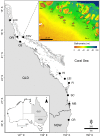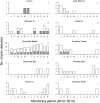Evidence of Partial Migration in a Large Coastal Predator: Opportunistic Foraging and Reproduction as Key Drivers?
- PMID: 26841110
- PMCID: PMC4740466
- DOI: 10.1371/journal.pone.0147608
Evidence of Partial Migration in a Large Coastal Predator: Opportunistic Foraging and Reproduction as Key Drivers?
Abstract
Understanding animal movement decisions that involve migration is critical for evaluating population connectivity, and thus persistence. Recent work on sharks has shown that often only a portion of the adult population will undertake migrations, while the rest may be resident in an area for long periods. Defining the extent to which adult sharks use specific habitats and their migratory behaviour is essential for assessing their risk of exposure to threats such as fishing and habitat degradation. The present study used acoustic telemetry to examine residency patterns and migratory behaviour of adult bull sharks (Carcharhinus leucas) along the East coast of Australia. Fifty-six VR2W acoustic receivers were used to monitor the movements of 33 bull sharks in the central Great Barrier Reef (GBR). Both males and females were detected year-round, but their abundance and residency peaked between September and December across years (2012-2014). High individual variability in reef use patterns was apparent, with some individuals leaving the array for long periods, whereas others (36%) exhibited medium (0.20-0.40) or high residency (> 0.50). A large portion of the population (51%) undertook migrations of up to 1,400 km to other coral reefs and/or inshore coastal habitats in Queensland and New South Wales. Most of these individuals (76%) were mature females, and the timing of migrations coincided with the austral summer (Dec-Feb). All migrating individuals (except one) returned to the central GBR, highlighting its importance as a potential foraging ground. Our findings suggest that adult bull sharks appear to be highly dependent on coral reef resources and provide evidence of partial migration, where only a portion of the female population undertook seasonal migrations potentially to give birth. Given that estuarine habitats face constant anthropogenic pressures, understanding partial migration and habitat connectivity of large coastal predators should be a priority for their management.
Conflict of interest statement
Figures








Similar articles
-
Contrasting movements and connectivity of reef-associated sharks using acoustic telemetry: implications for management.Ecol Appl. 2015 Dec;25(8):2101-18. doi: 10.1890/14-2293.1. Ecol Appl. 2015. PMID: 26910942
-
Reef-fidelity and migration of tiger sharks, Galeocerdo cuvier, across the Coral Sea.PLoS One. 2014 Jan 8;9(1):e83249. doi: 10.1371/journal.pone.0083249. eCollection 2014. PLoS One. 2014. PMID: 24421879 Free PMC article.
-
Multi-tissue stable isotope analysis and acoustic telemetry reveal seasonal variability in the trophic interactions of juvenile bull sharks in a coastal estuary.J Anim Ecol. 2014 Jan;83(1):199-213. doi: 10.1111/1365-2656.12106. Epub 2013 Aug 8. J Anim Ecol. 2014. PMID: 23927728
-
There and back again: a review of residency and return migrations in sharks, with implications for population structure and management.Ann Rev Mar Sci. 2015;7:547-70. doi: 10.1146/annurev-marine-010814-015730. Epub 2014 Sep 18. Ann Rev Mar Sci. 2015. PMID: 25251267 Review.
-
The role of acoustic telemetry in assessing fish connectivity within marine seascapes: A global review.J Fish Biol. 2025 May;106(5):1285-1304. doi: 10.1111/jfb.16011. Epub 2024 Dec 5. J Fish Biol. 2025. PMID: 39635955 Review.
Cited by
-
Long-term patterns of abundance, residency and movements of bull sharks (Carcharhinus leucas) in Sydney Harbour, Australia.Sci Rep. 2019 Dec 11;9(1):18864. doi: 10.1038/s41598-019-54365-x. Sci Rep. 2019. PMID: 31827123 Free PMC article.
-
Movements and residency of Caribbean reef sharks at a remote atoll in Belize, Central America.R Soc Open Sci. 2021 Aug 11;8(8):201036. doi: 10.1098/rsos.201036. eCollection 2021 Aug. R Soc Open Sci. 2021. PMID: 34430037 Free PMC article.
-
Both Environmental Conditions and Intra- and Interspecific Interactions Influence the Movements of a Marine Predator.Ecol Evol. 2024 Nov 28;14(12):e70659. doi: 10.1002/ece3.70659. eCollection 2024 Dec. Ecol Evol. 2024. PMID: 39619778 Free PMC article.
-
Multi-year tracking reveals extensive pelagic phase of juvenile loggerhead sea turtles in the North Pacific.Mov Ecol. 2016 Oct 3;4:23. doi: 10.1186/s40462-016-0087-4. eCollection 2016. Mov Ecol. 2016. PMID: 27729983 Free PMC article.
-
Bull Shark (Carcharhinus leucas) Occurrence along Beaches of South-Eastern Australia: Understanding Where, When and Why.Biology (Basel). 2023 Aug 31;12(9):1189. doi: 10.3390/biology12091189. Biology (Basel). 2023. PMID: 37759589 Free PMC article.
References
-
- Heupel MR, Hueter RE. Use of an automated acoustic telemetry system to passively track juvenile blacktip shark movements In: Sibert J, Nielsen J, editors. Electronic Tagging and Tracking in Marine Fisheries: Proceedings. Dordrecht: Kluwer Academic Publishers; 2001. pp. 217–236.
-
- Sims DW, Southall EJ, Richardson AJ, Reid PC, Metcalfe JD. Seasonal movements and behaviour of basking sharks from archival tagging: no evidence of winter hibernation. Mar Ecol Prog Ser. 2003;248: 187–196.
-
- Dicken M, Booth AJ, Smale M. Preliminary observations of tag shedding, tag reporting, tag wounds, and tag biofouling for raggedtooth sharks (Carcharias taurus) tagged off the east coast of South Africa. ICES J Mar Sci. 2006;63: 1640–1648.
Publication types
MeSH terms
LinkOut - more resources
Full Text Sources
Other Literature Sources
Research Materials

